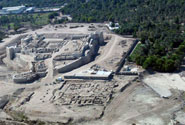|
Other Archaeological Sites / The Neolithic of the Levant (500 Page Book Online) Bahrain Archipelago
Bahrain has been inhabited since prehistoric times and several thousand burial mounds in the northern part of the main island probably date from the Sumerian Period of the 3rd millennium BC. It was the seat of ancient Dilmun -- a prosperous trading centre linking Sumer with the Indus Valley about 2000 BC. The archipelago was mentioned by Persian -- Greek -- Roman geographers and historians. Bahrain is rich in history and ancient civilizations have only recently been discovered by international archaeologists. Its believed that for tens of thousands of years nomads traveled over Bahrain's desert and primitive flint tools were found testifying to this history. Recent finds have evidenced that Bahrain was indeed the site of the lost civilization of Dilmun dating from the third millennium BC -- often refereed to as the fabled Garden of Eden and described as paradise in the Epic of Gilgamesh. The land is repeatedly mentioned in Sumerian -- Babylonian -- Assyrian inscriptions as an important seaport between Mesopotamia and the Indus Valley. By 600 BC Bahrain was absorbed into the New Babylonian Empire and once again flourished as a prosperous entity. In 323 BC two of Alexander the Great's ships arrived and new trade routes were opened resulting in such a strong Greek influence that Dilmun was renamed Tylos. Bahrain was also the site of the largest prehistoric cemetery in the world. At one stage an estimated 170,000 burial mounds covered the central and western areas. Archaeological finds of those that have been uncovered reveal evidence of two distinct civilizations -- the Dilmun and Tylos -- two thousand years apart and dating from the third and first millennia respectively ... |

